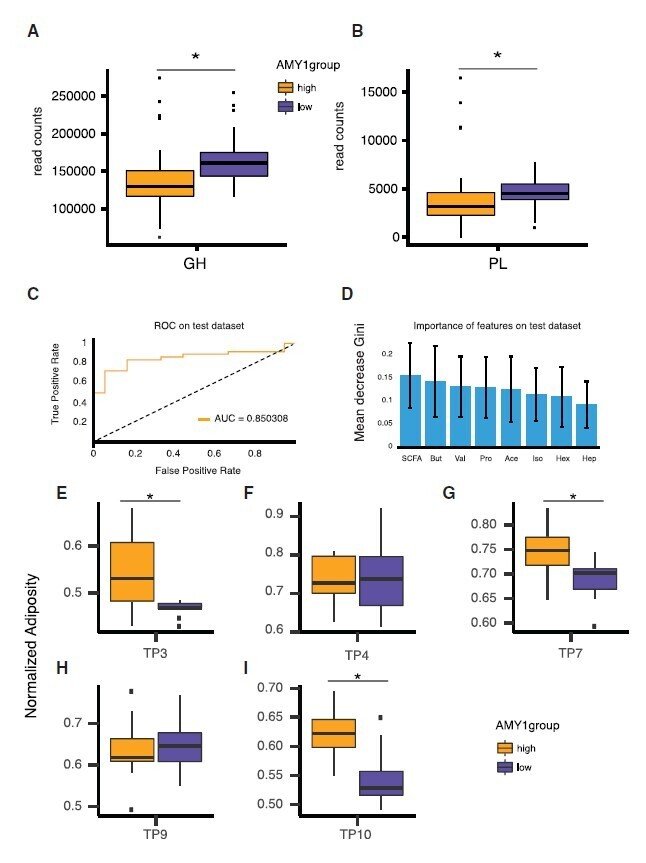「81、ヒト唾液アミラーゼ遺伝子のコピー数は腸内微生物叢に影響する」
0,引用元
「口腔細菌叢は唾液の流量、pH、アミラーゼ活性、凝集活性、抗菌物質、ホルモンなど、宿主の遺伝的要因にも影響を受けることになる。最近の報告として唾液アミラーゼ遺伝子AMY1のコピー数と口腔Porphyromonas菌種の比率に相関があることが報告されている (ref. 81)。」
1,引用文献
2,ABSTRACT
宿主の遺伝的多型は微生物叢の構成に影響を及ぼす。これまでの研究では腸内微生物叢と特定の対立遺伝子との関連に焦点が当てられてきたが、遺伝子コピー数(CN)にもばらつきがある。我々は微生物叢の多様性と、でんぷんの消化を促進する唾液アミラーゼをコードするAMY1遺伝子座のCNのばらつきとの関連性を調べた。約1,000人の被験者についてAMY1-CNを推定した後、AMY1-CNの高い被験者と低い被験者の糞便微生物叢を区別する分類群を特定した。1か月間の食事介入研究では、食事の標準化が腸内微生物叢の収束を促し、AMY1-CNが口腔および腸内微生物叢の構成と機能と相関していることが示された。AMY1-CNの低い被験者の微生物叢は、複合糖質の分解能力が強化されていた。AMY1-CN値の高い被験者は、唾液中のPorphyromonas菌のレベルが高く、腸内細菌叢にはレジスタントスターチを分解する微生物が豊富に存在し、短鎖脂肪酸の産生量も多く、無菌マウスに移植すると肥満度が高くなることが分かった。この研究により、AMY1-CNが腸内細菌叢の構成と機能に関連する遺伝因子であることが証明された。

3,RESULTS

(A) Diploid AMY1-CN distribution for 105 subjects, from which the 25 intervention subjects were selected, was obtained using qPCR with primer sequences previously reported (Perry et al., 2007). (B) Mean amylase activity per mL of saliva ± SEM at each time point for the 25 individuals in the AMY1-CN intervention groups. Measurements were performed in triplicate for both qPCR and salivary amylase activity.

(A) Alpha diversity assessed with the metric Chao 1 (n = 25). (B) Principal coordinate analysis (PCoA) of the unweighted UniFrac distances between samples collected from all 25 subjects throughout the study. The first two PCs are plotted. The percent variation explained by each PC is indicated on the axes. Samples are colored according to AMY1-CN group. See also Figure S2.

(A and B) Boxplots of the read counts in the AMY1H and AMY1L groups for each of the significantly different carbohydrate-active enzyme classes: glycoside hydrolases (GH; A) and polysaccharide lyases (PL; B) (n = 20). (C) We used machine learning to assess whether SCFA levels were predictive of SAA. Subjects were clustered according to their salivary amylase activity in two groups (SAA-H and SAA-L) by k-means clustering (n = 25). Shown here is the receiver operating characteristic (ROC) curve of a random forest model used to predict the SAA group using the SCFA measurements in a test dataset. (D) The features used by the random forest model for the classification of the test samples are shown in decreasing order of importance given by the mean decrease in Gini index. SCFA is the total of all SCFAs. But, butyrate; Val, valerate, Pro, propionate; Ace, acetate; Iso, isovalerate; Hex, hexanoate; Hep, heptanoate. (E–I) Boxplots of the adiposity measure normalized by baseline weight on the day of inoculation of formerly germ-free mice after humanization with stool collected from the study participants at 5 time points: (E) TP3; (F) TP4; (G) TP7; (H) TP9; (I) TP10. *Tukey’s HSD adjusted p < 0.05. See also Figures S6 and S7.
4,DISUCUSSION
宿主のAMY1コピー数が食事非依存的に口腔内マイクロバイオームに影響を与えることが観察された。1ヶ月間の介入研究では、被験者が炭水化物を多く含む食品を毎日摂取するように、2週間の食事の標準化を行った。経口マイクロバイオームは、最初に食物摂取の影響を受けたが、標準化された食事期間の影響を受けなかった。しかし、宿主のAMY1-コピー数やSAAには敏感であった。注目すべきは、AMY1Lowと比較して、AMY1High唾液マイクロバイオームは、Porphyromonas属の高い割合を示したことである。
口腔マイクロバイオームとは対照的に、標準化された食事期間は、特に機能レベルで腸内マイクロバイオームに顕著な影響を及ぼした。食事による腸内細菌叢の収束は以前から観察されている。収束にもかかわらず、高AMY1-コピー数群と低AMY1-コピー数群の腸内細菌叢の差は維持された。
